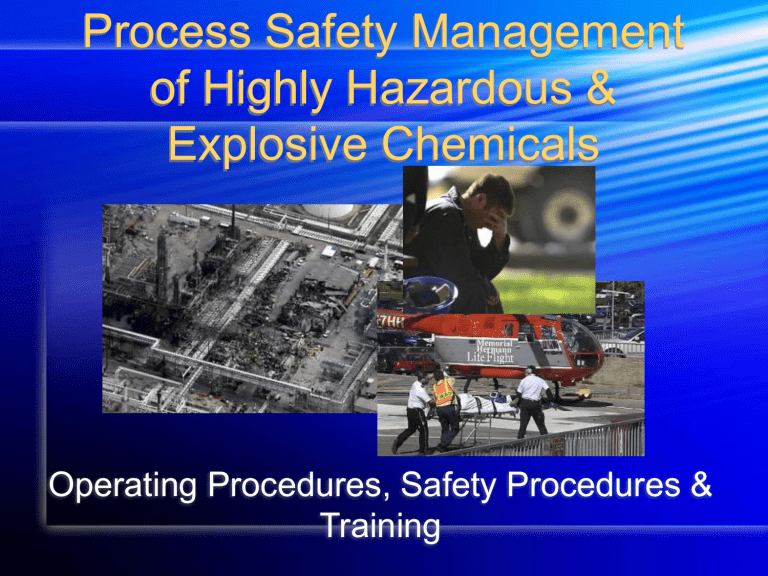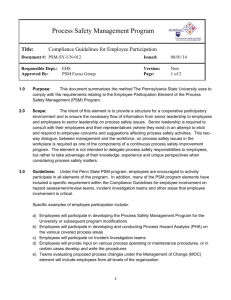
Process Safety Management of Highly Hazardous & Explosive Chemicals Operating Procedures, Safety Procedures & Training Now that the PHA’s Are Competed or Underway… Operating Procedures & Safety Programs Must Be Developed PHA Information Can Be Used Operating Procedures 1910.119(f) Operating Procedures & Safety Programs Must Consider: Initial start-up Normal operations Temporary operations Emergency shutdown Emergency operations Normal shutdown Start-up following turnaround Consequences of deviation Steps required to correct or avoid deviation Operating Procedures or Standard Operating Procedures (SOP’s) Where Did This Methodology Come From? Answer: The Military Definition: A standard operating procedure is a set of instructions having the force of a directive, covering those features of operations that lend themselves to a definite or standardized procedure without loss of effectiveness. Standard Operating Policies and Procedures can be effective catalysts to drive performance improvement and improving organizational results. Every good quality system is based on its standard operating procedures (SOPs). Operating Procedures Develop and implement written operating procedures* consistent with the process safety information and addresses at least the following elements: Initial start-up, normal and temporary operations Normal and emergency shut-down procedures Operating limits and consequences of deviation Hazards presented by the process *Readily accessible to employees Operating Procedures The operating procedures addressing operating parameters will contain operating instructions about: pressure limits temperature ranges flow rates…and what to do when an upset condition occurs what alarms and instruments are pertinent if an upset condition occurs, and other subjects. Operating Procedures - Start Up…We Must Describe normal SOP's Describe start-up SOP's Describe Shut-down SOP’s Operating Procedures - Start Up…We Must Include Sections such as: Objectives Purpose Concerns Procedures Department Operator Equipment Involved Location Related Documents Let’s Look at An Example… Process Safety Management Procedure - Revision HPR-1 Revision Date: 1-9-2009 by: SWD Objective This procedure is designed to describe the Technical Operating Specifications (TOS), and to set down the Standard Operating Procedures for the safe operation of Ammonia High Pressure Receiver 1 (HPR-1) Purpose: The purpose of the TOS is to provide a description of the High Pressure Receiver, to define the function of the receiver, its operating conditions and limits, and consequences of deviation from these limits; To describe controls and instrumentation and safety systems, and set operating alignments. The purpose of the Standard Operating Procedure (SOP) is to set down the proper steps for starting, monitoring normal operation, and stopping and restarting the Receiver under normal and emergency conditions Concerns: Very Careful attention to valve positions, temperature, and pressure levels is extremely important to the successful completion of these procedures. Deviations from normal operating limits could cause personal injury or death, small to catastrophic release of ammonia or environmental damage, or evacuation of, or injury to, members of the public. We seek to prevent incidents such as: Injury to operators and others in the area. Damage to the High Pressure Receiver. Release of any quantity of Anhydrous Ammonia refrigerant. The company Lockout/Tagout program shall be followed when taking the receiver out of service, while maintaining the receiver, and while returning it to service. If Line-Breaking is required, all Line-Breaking precautions described in the company Line-Break Policy shall be observed. Additionally, proper PPE shall be immediately available, or worn in response to the threat level posed by the work and circumstances. Department: Refrigeration Operator: Qualified Refrigeration Operator(s) Equipment: Ammonia High Pressure Receiver, HPR-1 outside the south compressor room. Data from U-1-A: Vertical Receiver, Serial Number 124011, National Board Number 8664, built in 1998, by E.L. Nickell Company. MAWP: 250 psig @ 240。F Location: Related Documents: Initial Date of 4/1998 Development: Authorized By: Previous Revision: 4/1/1998 Annual Review By, 9/2001 plant engineer, utilities supervisor, two operators, the Process and Date: Safety Management (PSM) coordinator, and an outside consultant Operating Procedures Must be Developed for Each Equipment Operation in the Covered Process Refer to Block Diagrams Refer to P&ID Must Cover Normal Operating Conditions, Normal Operating Parameters, i.e.. Pressure/Flow/Current/ etc. Must Follow Procedures & Recommendations in PHA’s Must Follow Form Operating Procedures For Shut-down Procedures…Remember: Most operations must be shut down in a specific order! Failure to follow these shut down procedures could results in a catastrophic release or system failure Ammonia Plant Explosion Caused by Improper Shut-down of Engine Room Operating Procedures Operating Limits Operating Limits Must be Understood Pressures Flows Electrical Potential Tolerances Operating Procedures Hazards of the Process Operating Procedures Must Identify the Hazards of the Process in All Phases: Start Up Normal Operating Conditions Temporary Operating Condition Emergency Shutdown Now That We’ve Completed the Operating Procedures We Must Develop Safety Work Practices, Programs & Procedures for Covered Processes Safe Work Practices 1910.119(f)(1) Safe Work Practices •Develop and implement safe work practices* to provide for the control of hazards during operations such as: –Lockout/tagout; –Confined space entry; –Line Opening process equipment or piping; and –Control over entrance into a facility by maintenance, contractor, laboratory, or other support personnel *These safe work practices apply to contractor employees as well Safe Work Practices Safe Work Practices, Programs & Procedures must: Be specific to the Covered Process Follow Procedures & Recommendations in the PHA’s Follow Procedures in the Operating Procedures Must be Able to be Tracked Follow Form Safe Work Practices Lockout Tagout - One of the Most Important Procedures in PSM Must be Written Carefully & Follow all Procedures (PHA’s, Operating Procedures) Must be Followed to the Letter! Safe Work Practices Lockout/Tagout in PSM Why not Use Digital Imaging in Your Procedures to Identify Critical Lockout /Tagout Positions Safe Work Practices Line Opening Permits Identify Procedures for Opening any Process Line in a Covered Process Must Include Hazards of the Line Opening PPE Required Safe Work Practices Line & Equipment Opening A Hazard Review Must Completed for All Line/Equipment Hazards Including: HAZARDOUS MATERIALS IN SYSTEM POTENTIAL PHYSICAL HAZARDS BARRICADING AS REQUIRED FIRST AID IF EXPOSED LOCATION OF SAFETY EQUIPMENT PPE REQUIRED FOR LINE OPENING Safe Work PracticesHot Work A Program Must be Developed for the Covered Process That Requires: A Hot Work Permit be Issued for ALL Hot Work Performed in the Plant by Employees or Contractors A Permit must be Posted at the Location of the Hot Work A Fire Watch Is Required A Fire Extinguisher or Other Appropriate Fire Fighting Equipment Must Be Present, Fire Watch must be Trained in its use Paper Mill Explosion & Fire Caused by Failure to Follow Hot Work Procedures Safe Work Practices Must be Specific for the Covered Process May Require Additional Program other than Lockout Tagout, Line Opening & Hot Work…such as Confined Space, Electrical Safe Work Practices, Combustible Dust Now That We’ve Developed Safe Work Practices We Have to Train Training 1910.119(g) PSM 29CFR1910.119(g) Requires (G) Training (Initial, Refresher, and Documentation) (paragraphs (g)(1), (g)(2), and (g)(3)). Paragraph (g)(1) requires employers to train employees operating dangerous process. Paragraph (g)(2) requires that the employer provide refresher training at least every three years. Paragraph (g)(3) requires the employer to prepare a record that contains the name of employee, the date of training, and the means used to verify that the employee understood the training PSM Training PSM Training Programs Must be Developed for: Affected Employees - Those not Directly Involved in the Process Operation Authorized Employees - Those Directly Involved in the Process Operation Contractors Who May Perform Work on a Covered Process Vendors/Visitors who May Visit the Facility and May Potentially be Exposed to the Covered Process PSM Training Training Must Be Performed as Follows: Initial training Prior to work assignment Waved for those already in Refresher training Every a process three years All Training Must be Documented PSM Training Training Subjects Must Include at Least: Lockout Tagout Hot Work Line & Equipment Opening Confined Space (if applicable) Emergency Response Examples of Training PSM training example including the means used to verify that the employee understood the training. Let’s Use Hot Work Procedures Safe Work Practices Hot Work Program EXAMPLES OF HOT WORK Safe Work Practices Hot Work Burning, Welding, Grinding Our Program Requires A Hot Work Permit be Issued for ALL Hot work Performed in the Plant by Employees or Contractors Permit must be Posted at the Location of the Hot Work Fire Watch Is Required Fire Extinguisher Must Be Present, Fire Watch must be Trained in its use Safe Work Practices HOT WORK PERMIT MUST BE COMPLETED PRIOR TO BEGINNING WORK INVOLVIING ANY HOT WORK PERMIT SHALL BE DISPLAYED AT THE LOCATION OF THE ACTUAL HOT WORK OPERATION VERIFICATION OF UNDERSTANDING WORKSHEET HOT WORK CIRCLE THE CORRECT ANSWER 1. A HOT WORK permit must be obtained prior to beginning HOT.work by welders and contractors before beginning a job. TRUE 2. A HOT WORK permit is not necessary if just burning and grinding is being done on a job. FALSE 3. Contractors are not required to obtain HOT WORK permits. FALSE 4. The employee or contractor will obtain a HOT WORK permit from his supervisor and must determine if conditions are safe and have a fire watch if necessary. TRUE 5. HOT WORK is permitted in explosive atmospheres, around hazardous tanks and equipment. FALSE 6. The following protective measures can be used: damp sand on floors, protective shields, or fire resistant coverings while Hot Work is taking place. TRUE 7. 35 feet is a good safe distance for covered combustibles to be away from HOT WORK. TRUE 8. Fully charged and operable fire extinguishers and/or hose lines shall be available and ready. TRUE 9. The HOT WORK permit shall be posted at the job site, and the supervisor shall retain the permits for three (3) days. TRUE 10. The fire watch does not have to be trained in fire extinguishing and is not responsible for sounding an alarm in the event of a fire. FALSE PSM Operating Procedures Summary You Must Develop and implement written operating procedures consistent with the process safety information and addresses at least the following elements: Initial start-up, normal and temporary operations Normal and emergency shut-down procedures Operating limits and consequences of deviation Hazards presented by the process PSM Safe Work Practices Summary Safe Work Practices, Programs & Procedures must: Be specific to the Covered Process(s) Follow Procedures & Recommendations in the PHA’s Follow Procedures in the Operating Procedures Must be Able to be Tracked Follow Form PSM Training Summary PSM Training Programs Must be Developed for All Necessary Workers and Contractors Verification of Understanding is Required Training Must Be Performed as Follows: Initial training Refresher training Prior to work assignment Waved for those already in a process Every three years All Training Must be Documented What’s Next? In the Last Session, we will Cover Contractor Pre-Qualification, Emergency Planning & Response Audits, and EPA Risk Management Plans (RMP)




